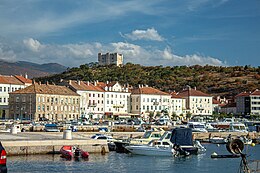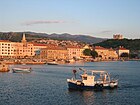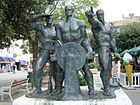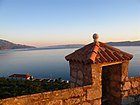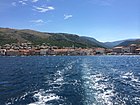Senj
Senj | |
|---|---|
| Grad Senj Town of Senj | |
Clockwise, from top: Senj harbour, City walls, medieval city hall,Nehaj,Co-Cathedral of the Assumption of Mary, Senj,Bell tower of the Co-Cathedral | |
 | |
| Coordinates:44°59′24.52″N14°54′10.96″E/ 44.9901444°N 14.9030444°E | |
| Country | |
| County | |
| Government | |
| • Mayor | Jurica Tomljanović (HDZ) |
| • Town Council | 13 members |
| Area | |
| •Town | 657.9 km2(254.0 sq mi) |
| • Urban | 3.2 km2(1.2 sq mi) |
| Elevation | 0 m (0 ft) |
| Population (2021)[2] | |
| •Town | 5,973 |
| • Density | 9.1/km2(24/sq mi) |
| •Urban | 4,164 |
| • Urban density | 1,300/km2(3,400/sq mi) |
| Time zone | UTC+1(CET) |
| • Summer (DST) | UTC+2(CEST) |
| Postal code | 53 270 |
| Area code | 053 |
| Website | senj |
Senj(Croatian:[sêɲ];[3]Italian:Segna;Latin:Senia;HungarianandGerman:Zengg) is a town on the upperAdriaticcoast in Croatia, in the foothills of theMala KapelaandVelebitmountains.
The symbol of the town is theNehaj Fortress(Croatian:Tvrđava Nehaj) which was completed in 1558. For a time this was the seat of theUskoks(Italian:Uscocchi), who were Christian refugees fromOttoman Bosniaresettled here to protect theHabsburgborderlands. TheRepublic of Veniceaccused the Uskoks ofpiracyand declaredwar on themwhich led to their expulsion following a truce in 1617.
Senj is to be found in theLika-Senj Countyof Croatia, theRoman Catholic Diocese of Gospić-Senjand theRoman Catholic Archdiocese of Rijeka.
History[edit]

Senj has apparently been inhabited since prehistoric times. Senj is an old settlement founded more than 3000 years ago on Kukhill,which iseastof today's Senj.[4]A settlement called Athyinites or Athuinites (Αθυινιτες) in today's Senj was mentioned inGreekdocuments dated to 4th century BC.[4]TheIllyriantribesIapodesandLiburniansinhabited the area as it was located in Illyria.
Seniawas a thriving town in theRomanprovince ofDalmatia,used by the Romans as a stronghold against the Illyrians in the 2nd century BC. After the fall of the Roman Empire, theAvarsand theCroatseventually settled here in the 7th century AD.
The Catholicdiocese of Senjwas established in 1169. King ofHungaryBéla IIIgave the town to theKnights Templarin 1184, and in 1271 it became the property of theFrankopancounts ofKrk.
In 1248 the bishop of Senj was allowed byPope Innocent IVto use theGlagolitic alphabetand thevernacularin liturgy. A Glagoliticprinting presswas set up in 1494 and produced theincunabulaThe Glagolic MissalandSpovid općena.
The military captaincy of Senj was established in 1469 in order to defend against the invadingOttomanandVenetianarmies. The town sheltered thousands of refugees from nearby occupied areas. TheNehaj Fortresswas completed in 1558 on the hillNehaj,which at the time was outside of town. Today it is wholly within the town's borders. Thewars with the Ottomanslasted well into the 17th century. During this time theUskokslived in Senj and occupied its fortress. One of the most significant Uskoks wasIvo Senjanin(Ivo of Senj), who frequently launched expeditions against the Ottomans until his execution in 1612. They served an important purpose during the wars since they had small units of men rowing swift boats that proved to be very effectiveguerrillaforces. However, after theUskok Warwith Venice, which ended in 1617, they were forbidden to settle in the area. Prince Radic was appointed Prince of Senj by king Rudolf emperor of Austria (1 December 1600). (Radic family) Native noble family from Lika region; members of the family were Uskok military leaders at the headquarters in Senj.
Notable polymath and writerPavao Ritter Vitezovićwas born within the city walls in 1652, whose work later inspired theIllyrian movement.
The 18th century brought some prosperity, especially with the construction of theJosephina(named afterEmperor Joseph II) linking the Adriatic coast via Senj toKarlovac.The railway line built in 1873 between Fiume (Rijeka) and Karlovac did not pass by Senj which held back further development.
Until 1918, the town was part of theAustrian monarchy(Kingdom of Croatia-Slavonia,Lika-Krbava Countyafter thecompromise of 1867), in theCroatian Military Frontier(Regiment III).[5][6]
In the fall of 1943, duringWorld War II,whenFascist Italycapitulated, thePartisanstook control of Senj and used it as a supply port. Subsequently, theLuftwaffestarted bombarding the town. By the end of the year they had demolished over half of the buildings in town and inflicted heavy civilian casualties.[7]
Climate[edit]
Senj has a temperate climate which is usually described as temperate Oceanic or Marine west coast, with mild, windy winters and relatively dry and warm summers. According to the Köppen climate classification it falls within a cool, dry-summer subtropical zone (Csb), with cool-summer Mediterranean characteristics such as its usually dry summers.
| Climate data for Senj | |||||||||||||
|---|---|---|---|---|---|---|---|---|---|---|---|---|---|
| Month | Jan | Feb | Mar | Apr | May | Jun | Jul | Aug | Sep | Oct | Nov | Dec | Year |
| Record high °C (°F) | 20.3 (68.5) |
22.2 (72.0) |
25.9 (78.6) |
29.5 (85.1) |
33.6 (92.5) |
36.3 (97.3) |
39.7 (103.5) |
38.6 (101.5) |
35.6 (96.1) |
29.9 (85.8) |
26.9 (80.4) |
20.9 (69.6) |
39.7 (103.5) |
| Daily mean °C (°F) | 6.1 (43.0) |
6.6 (43.9) |
9.5 (49.1) |
13.3 (55.9) |
17.9 (64.2) |
21.9 (71.4) |
24.5 (76.1) |
24.2 (75.6) |
20.2 (68.4) |
15.6 (60.1) |
11.1 (52.0) |
7.5 (45.5) |
14.9 (58.8) |
| Record low °C (°F) | −11.8 (10.8) |
−16.6 (2.1) |
−9.3 (15.3) |
−0.8 (30.6) |
3.4 (38.1) |
7.6 (45.7) |
10.5 (50.9) |
8.2 (46.8) |
6.7 (44.1) |
1.6 (34.9) |
−4.9 (23.2) |
−10.4 (13.3) |
−16.6 (2.1) |
| Averageprecipitationmm (inches) | 94.2 (3.71) |
90.4 (3.56) |
86.7 (3.41) |
96.1 (3.78) |
91.7 (3.61) |
84.9 (3.34) |
64.5 (2.54) |
94.6 (3.72) |
137.9 (5.43) |
143.4 (5.65) |
165.3 (6.51) |
124.5 (4.90) |
1,274.2 (50.16) |
| Average rainy days | 10 | 9 | 10 | 12 | 11 | 10 | 8 | 8 | 9 | 10 | 13 | 12 | 122 |
| Average snowy days | 2 | 3 | 2 | 0 | 0 | 0 | 0 | 0 | 0 | 0 | 1 | 2 | 10 |
| Mean monthlysunshine hours | 100.9 | 123.2 | 158.1 | 187.7 | 242.7 | 265.8 | 310.2 | 287.2 | 214.7 | 167.6 | 101.8 | 90.2 | 2,250.1 |
| Source:Croatian Meteorological and Hydrological Service[8] | |||||||||||||
Economy[edit]

Modern Senj is a seaside tourist town. Primary industries are fishing, boating, and tourism.
Population[edit]
As of the 2021 census, Senj had a population of 5,973, with 97.30% being ethnic Croats. The largest minorities are Serbs with a population of 43 (0.72%) and Albanians with a population of 27 (0.45%)[9][10]
| population | 13268 | 15295 | 14782 | 14852 | 15857 | 16713 | 14963 | 14572 | 13289 | 12953 | 12235 | 10399 | 9582 | 9205 | 8132 | 7182 | 5973 |
| 1857 | 1869 | 1880 | 1890 | 1900 | 1910 | 1921 | 1931 | 1948 | 1953 | 1961 | 1971 | 1981 | 1991 | 2001 | 2011 | 2021 |
There are 27 settlements in the Town of Senj and they include (population as of 2011):[11]
- Alan,population 17
- Biljevine,population 51
- Bunica,population 85
- Crni Kal,population 72
- Jablanac,population 83
- Klada,population 39
- Krasno,population 476
- Krivi Put,population 33
- Lukovo,population 36
- Melnice,population 57
- Mrzli Dol,population 28
- Pijavica,population 262
- Podbilo,population 25
- Prizna,population 45
- Senj,population 4,810
- Senjska Draga,population 85
- Starigrad,population 15
- Stinica,population 73
- Stolac,population 41
- Sveta Jelena,population 16
- Sveti Juraj,population 599
- Velike Brisnice,no population
- Veljun Primorski,population 70
- Volarice,population 86
- Vrataruša,population 11
- Vratnik,population 59
- Vrzići,population 8
Notable people[edit]
- Blaž Baromić(c. 1450 – 1505)
- Nikola Jurišić(1490 – 1545)
- Ivo Senjanin(c. 1571 – 1612)
- Pavao Ritter Vitezović(1652 – 1713)
- Ivan Paskvić(1754 – 1829)
- Vjenceslav Novak(1859 – 1905)
- Silvije Strahimir Kranjčević(1865 – 1908)
- Milan Ogrizović(1877 – 1923)
- Eugen Kvaternik(1825 – 1871)
- Milan Moguš
- Vladimir Ćopić
- Sandra Šarić
- Edi Karić
- Domagoj Krajina
- Milan Ćopić
Twin towns – sister cities[edit]
Gallery[edit]
-
Senj waterfront
-
Senj harbor chained with snow after a cold front
-
The Three Seamenstatue
-
TheSundialin the town that lies on thenorth 45th parallel
-
View of the Adriatic Sea
-
Thefortress Nehajis the most famous monument and symbol of Senj
-
A view of Senj from the sea.
References[edit]
- ^Register of spatial units of the State Geodetic Administration of the Republic of Croatia.WikidataQ119585703.
- ^"Population by Age and Sex, by Settlements"(xlsx).Census of Population, Households and Dwellings in 2021.Zagreb:Croatian Bureau of Statistics.2022.
- ^Deanović, Mirko; Jernej, Josip (1975). "Sȅnj".Hrvatsko ili srpsko-talijanski rječnik(4th ed.). Zagreb: Školska knjiga.
- ^ab"Povijest grada | Grad Senj – Službene stranice Grada Senja".www.senj.hr.RetrievedMay 24,2023.
- ^Perhaps Regiment II. The map shows Zengg at the borderline between II and III.
- ^Handbook of Austria and Lombardy-Venetia Cancellations on the Postage Stamp Issues 1850–1864, by Edwin MUELLER, 1961.
- ^Mihael Sobolevski (December 1, 2003)."Bombardiranje Senja zrakoplovima u Drugom svjetskom ratu".The Review of Senj(in Croatian). City Museum Senj – Senj Museum Society.ISSN0582-673X.
- ^"Mjesečne vrijednosti za Senj u razdoblju1948−2014"(in Croatian). Croatian Meteorological and Hydrological Service.RetrievedDecember 3,2015.
- ^"Stanovništvo u najvećim gradovima, općinama i naseljima"[Population in major towns, municipalities and settlements](xlsx).Census of Population, Households and Dwellings in 2021.Zagreb:Croatian Bureau of Statistics.2022.
- ^"Population by Towns/Municipalities"(xlsx).Census of Population, Households and Dwellings in 2021.Zagreb:Croatian Bureau of Statistics.2022.
- ^"Population by Age and Sex, by Settlements, 2011 Census".Census of Population, Households and Dwellings 2011.Zagreb:Croatian Bureau of Statistics.December 2012.
- ^"Gradovi prijatelji Grada Senja"(in Croatian). Senj.RetrievedFebruary 8,2024.

